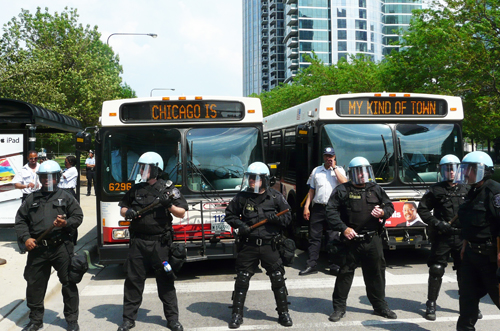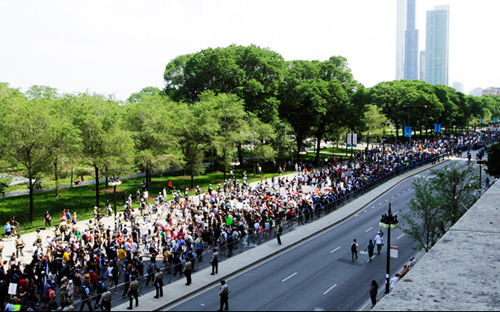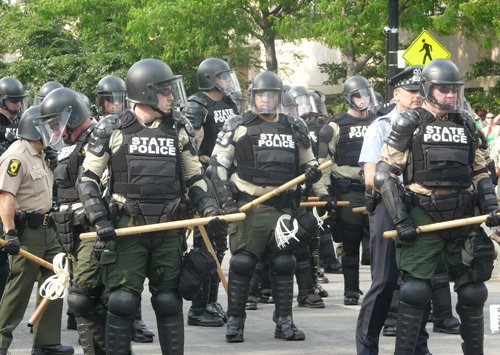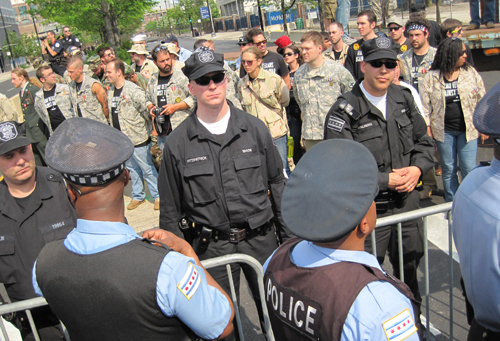Rahm's fascism -- a reminder... Wexler movie documents NATO in Chicago 2012
Mayor 1% (Rahm Emanuel) invited the G-8 (the Group of 8 most economically powerful countries in the world) and NATO (North Atlantic Treaty Organization) to meet in Chicago in May 2012. Needless to say, this did not go over well with Chicago activistsŚand a whole lot more other people.
 Many of the police who were deployed against the NATO protests wore black uniforms, drawing comparisons with the forces of a previous era of 'black shirts' and fascism. Substance photo by Kati Gilson.Academy Award-winning videographer Haskell Wexler, who grew up in Chicago, joined with two other videographers from Chicago, Andy Davis and Mike Gray, to make a film about the G-8/NATO meetings in Chicago. (G-8 later chickened out and hid in Camp David, MD, and never came to Chicago, so it just became about NATO.)
Many of the police who were deployed against the NATO protests wore black uniforms, drawing comparisons with the forces of a previous era of 'black shirts' and fascism. Substance photo by Kati Gilson.Academy Award-winning videographer Haskell Wexler, who grew up in Chicago, joined with two other videographers from Chicago, Andy Davis and Mike Gray, to make a film about the G-8/NATO meetings in Chicago. (G-8 later chickened out and hid in Camp David, MD, and never came to Chicago, so it just became about NATO.)
[Four Days in Chicago: A film by Haskell Wexler, Andy Davis and Mike Gray (2013). Available for $15 from www.fourdaysinchicago.com]
These videojournalists wanted to get an on-the-ground look at what was happening in Chicago, confident an honest rendition of events would not be presented by the corporate media. As they wrote:
"As long as the corporate media and Rahm Emanuel could engender fear of the faceless invaders, who were presented as disorganized, lawless interlopers who would disrupt the stability and reputation of Chicago, he and NATO would not be challenged. Local media gave big coverage to a few minor scuffles to demonstrate the superiority of 'security.'ö
Outside of the city, the country knew very little of the size and scope of the demonstrations. Wexler and his team spent four days wondering around the Loop, interviewing all kinds of people, trying to get a handle of what was going on. They saw cops, cops and more cops: they really illustrate what the ōright to free speechö means to Mayor 1%: nothing. (Not only did Mayor 1% bring in the Illinois State Police, but he brought in police from Milwaukee and Charlotte, NC, too.).
 The main anti-NATO march in May 2012 was virtually blacked out by the corporate media, which followed Rahm Emanuel's paranoid focus on potential "violent protesters."Yet this is not a film just about repression, as present as it was. One gets an understanding of the attitude of Wexler and his team when the DVD opens: instead of that stupid FBI warning you see with all DVDs -- threats of fines, imprisonment and all that crap -- the filmmakers made a statement to ignore that stuff. Further, they say anyone who bought the film can make a copy legally. A whole different attitude. And then the Title shows, with a singer sharing part of David RovicsÆ wonderful song ōStay Right Here.ö This sets the stage for a very poignant and powerful film.
The main anti-NATO march in May 2012 was virtually blacked out by the corporate media, which followed Rahm Emanuel's paranoid focus on potential "violent protesters."Yet this is not a film just about repression, as present as it was. One gets an understanding of the attitude of Wexler and his team when the DVD opens: instead of that stupid FBI warning you see with all DVDs -- threats of fines, imprisonment and all that crap -- the filmmakers made a statement to ignore that stuff. Further, they say anyone who bought the film can make a copy legally. A whole different attitude. And then the Title shows, with a singer sharing part of David RovicsÆ wonderful song ōStay Right Here.ö This sets the stage for a very poignant and powerful film.
The filmmakers focused on Occupy Chicago, the National Nurses Union (NNU) and the Iraq Veterans Against the War (IVAW).
 Illinois State Police dispatched by Governor Pat Quinn were equipped with extra-long clubs for use against protesters. The State Police began bringing these weapons to Chicago in 2006 when they were deployed against immigrant rights marchers. Substance photo by Kati Gilson.The fact is that organizers were unwilling to be intimidated. Occupy Chicago played a key role in fighting the repression, and leading the resistance. When Mayor 1% tried to withdraw a legal permit from the NNU, the Nurses decided they were going to rally, permit or not; and Mayor 1% backed down. The Nurses held a very enthusiastic rally, demanding institution of a ōRobin Hoodö tax against stock trades Ś and their ōRobin Hoodö green hats were all over! And over 40 US military veterans threw their medals back in disgust at NATO.
Illinois State Police dispatched by Governor Pat Quinn were equipped with extra-long clubs for use against protesters. The State Police began bringing these weapons to Chicago in 2006 when they were deployed against immigrant rights marchers. Substance photo by Kati Gilson.The fact is that organizers were unwilling to be intimidated. Occupy Chicago played a key role in fighting the repression, and leading the resistance. When Mayor 1% tried to withdraw a legal permit from the NNU, the Nurses decided they were going to rally, permit or not; and Mayor 1% backed down. The Nurses held a very enthusiastic rally, demanding institution of a ōRobin Hoodö tax against stock trades Ś and their ōRobin Hoodö green hats were all over! And over 40 US military veterans threw their medals back in disgust at NATO.
The film is composed mainly of video shot by Wexler and associates, and they use the technique of Wexler walking around talking to activists as well as people on the street. But this video is interposed with clips from local Chicago media, so they show the contrast between the protestors, and their thoughtful critiques, and the corporate mediaÆs efforts to instill fear of the protestors in Chicagoans. There are a number of clips where the local media is focusing on the ōBlack Bloc,ö those ōtroublemakersö who were such a threat to Chicago. Four Days in Chicago illuminates the bankruptcy of the corporate media.
They also show numerous protests within the larger theme of resistance to empire and capitalism. Protests against foreclosures, immigration restrictions and against tar sands oil are shown, while links to protests in Tunisia, Egypt, Greece and Spain are made. The anti-NATO demonstrations are seen as part of a world-wide movement.
The focus on Iraq Veterans Against the War shares things from the vets that are rarely seen. The insanity of trying to block veterans from protesting is shown to be totally bankrupt. The last 20 minutes or so of the film are especially powerful. This is the final march of the protests, and it shows the protestors moving from Grant Park down to the place where the veterans were going to return their medalsŚI believe it was at Cermak and Michigan, but I canÆt remember, and I didnÆt see any signs to help me. The brilliance of the film crew is shown here: they got clips from inside the NATO meetings, where NATO brought in military representatives of the 28 nation members so as to ōhonorö them and while this is going on, the film is split to show the Iraq and Afghanistan US veterans throwing their medals at NATO on the outside of the meeting. The contrast between death and life could not be made more clearly.
In all, an excellent film that illuminates what happened in Chicago that captures well the spirit of resistance and demand for another world. This video team did a wonderful job.
Yet while the videographers wanted to capture all that was going on in Chicago against NATOŚto give the country a view of what was really going onŚthey still missed a bunch of efforts. There was over a month of events preceding the NATO meetings, and folks all over the Chicagoland area were putting on educational events, invading ōestablishmentö meetings, and developing alternative media capabilities. (For my efforts to report things from my perspective, see my ōChicago Spring: NATO and the 1% vs. the 99%,ö which is on-line at www.greens.org/s-r/59/59-11.html.) It was the larger monthÆs efforts that might prove more important in the long run, but Wexler and his crew give a strong account of the crucial period that NATO was in the city.
 Iraq Veterans Against War were blocked from going to the NATO events at Chicago's McCormick Place to tell their true stories about the devastation the wars the USA and NATO (mostly, troops from the USA) have been wreaking on both the soldiers who have to fight them but the people of the nations against which the armies have been unleashed. Substance photo by Sarah Chambers. The other critique I would add is that they present the anti-NATO protests as a ōone-timeö thing in Chicago. In reality, it was a part of the mobilization efforts that took place from the Uprising in WisconsinŚconsiderable numbers of Chicagoans went to Madison, including many of the IVAW vetsŚin early 2011, to the Labor Notes conference in Rosemont (a Chicago suburb) in May 2012, to the NATO protests later that May, and to the strike by the Chicago Teachers Union (CTU) in September 2012, where the CTU stopped Mayor 1%Æs efforts to destroy their union. The CTU had strong support from ChicagoÆs people, and I think the anti-NATO protests contributed to that willingness to resist the Mayor. Where things go from here remain to be seen, but the anti-NATO protests certainly were an important part of the mobilization.
Iraq Veterans Against War were blocked from going to the NATO events at Chicago's McCormick Place to tell their true stories about the devastation the wars the USA and NATO (mostly, troops from the USA) have been wreaking on both the soldiers who have to fight them but the people of the nations against which the armies have been unleashed. Substance photo by Sarah Chambers. The other critique I would add is that they present the anti-NATO protests as a ōone-timeö thing in Chicago. In reality, it was a part of the mobilization efforts that took place from the Uprising in WisconsinŚconsiderable numbers of Chicagoans went to Madison, including many of the IVAW vetsŚin early 2011, to the Labor Notes conference in Rosemont (a Chicago suburb) in May 2012, to the NATO protests later that May, and to the strike by the Chicago Teachers Union (CTU) in September 2012, where the CTU stopped Mayor 1%Æs efforts to destroy their union. The CTU had strong support from ChicagoÆs people, and I think the anti-NATO protests contributed to that willingness to resist the Mayor. Where things go from here remain to be seen, but the anti-NATO protests certainly were an important part of the mobilization.
Nonetheless, this is a film made by activists for activists. It tells the story of the protests from our sideŚand it deserves the widest thanks, support and purchasingŚfor educational programs in your area!
[Kim Scipes is the Chair of the Chicago Chapter of the National Writers Union, UAW #1981, AFL-CIO. He is the author of AFL-CIOÆs Secret War against Developing Country Workers: Solidarity or Sabotage? (Lexington Books, paperback, 2011Śdetails and 20% off cover price at http://faculty.pnc.edu/kscipes/book.htm), and author of a chapter in It Started in Wisconsin (Verso, 2011), edited by Mari Jo Buhle and Paul Buhle.]


By: Haskell Wexler
Four Days In Chicago review
We appreciate your review, and not just the flattering parts but your constructive comments as well. You have my email. Keep in touch because we plan on making more trouble.
Haskell Wexler and
Nick Golding (editor)